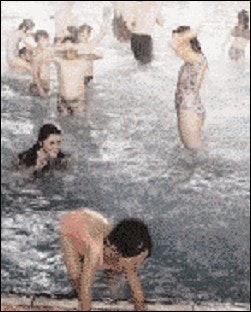The most problematic of facility areas from a risk-management perspective, the aquatic center requires constant vigilance in order for pool operators and staff to breathe easy

The facility in question was an outdoor pool with a diving well that was a uniform 12 feet deep, equipped with water jets close to the water line that pumped in fresh water for circulation. Water clarity, it seemed, was excellent. The pool happened to be photographed by an inspector on the morning of the accident, and photographed again by a patron within two hours of the incident. The water looked just great.
However, the action of the water jets made it hard to see to the pool's bottom, not to mention the waves caused by the divers breaking the water's surface and swimming to the pool's edge. In addition, a glare problem was evident as the sun sank lower in the sky, and nearby oak trees created a particular shade pattern across the surface. "If all these factors came together at the same time, it became tough to see," Pierce says.
Because the pool's operators were aware of the potential vision problems, they'd instituted a one-diver rule. The pool's deep end was divided by a line at the surface, which swimmers from the pool's shallow end were not allowed to cross. Only one diver was allowed into the diving well at a time, with the next diver waiting until the previous diver was safely to the pool's edge. In this way, the waiting divers acted as extra lifeguards.
On this afternoon, a constant line of divers, perhaps 20 at a time, waited their turn to jump or dive, a continuous set of eyes trained on the diving well - until someone spotted a body lying on the bottom. Still, most observers couldn't see it. "When the comment was first made that there was a body down there, everybody was laughing, 'No, there isn't,' from all their different vantage points," Pierce says. "They all thought it was a joke."
The boy's death was real, though, as was the family's subsequent lawsuit. As frustrating as it was for the boy's family and people on both sides of the case, what went wrong could not be pinpointed. He was last seen alive in the pool's shallow end, an hour before his body was found. How and where he went under, and at what time, no one could say with certainty.
Pierce says that it's just this type of case that makes managing risk in aquatic centers so problematic for facility owners.
"I was at a seminar and heard someone comment that you can't defend a pool drowning case - if it happens, you're liable," Pierce says. "Now, that's a jaded view of the world, and I don't agree with the broadness of it, but it sort of illustrates something that I do think is true: If somebody drowns in clear, filtered water and the pool is guarded, and the guards are doing what they should be doing, you've got a whole lot of explaining to do. For all intents and purposes, the burden of proof becomes yours."
When you reflect on changes in the leisure industry over the course of this century, you're confronted with improvements wherever you look - in water-filtration technology, in supervision techniques and in emergency preparedness. Still, the persistence of pool-related accidents is easy enough to explain. At the simplest level, accidents happen; a drowning can occur in the shallowest of depths. But pools have also added complicating features such as slides and wave-generators, and are serving more users than ever before.
Pool operators who build facilities in this era consider risk management in the design stage, paying close attention to glare, filtration, slip-safe surfaces, communications equipment and so on. But since the effects of most design flaws can be mitigated by hiring competent staff and utilizing them properly, most facility owners make personnel the foundation of their risk- management plan.
In this area, too, things have become more complicated, with many more lifeguard-certifying organizations than ever before - the Red Cross, Jeff Ellis & Associates, YMCA, U.S. Lifesaving Association and Boy Scouts of America - and a certain amount of competitive fervor both between these groups and between the pool operators who recognize one or any of the other certifications.
An increasing number of operators, though, are like Mike Giles, aquatics director at the University of Southern Mississippi. Giles says the training of prospective lifeguards at the pool where they'll work is far more important than the card they flash when they walk in the door.
"For so long in this business, if somebody walked in with a certificate, owners would say, 'Oooh, go sit on the deck!' That's just not good enough anymore," says Giles. "When that kid walks in your door, you need to find out whether he or she can perform for you. It doesn't matter whose name is on the back of the certificate."
As it happens, the type of pool will have a lot to do with which program a pool owner chooses. Ellis & Associates' supervisory techniques and liability-management approach have won that firm a devoted following at larger, privately-owned water parks. Everybody else cobbles together their emergency action plans from the best of each, as Giles does. "Both are excellent," he says. "The techniques and philosophies are a little different, but you know, it's the same process for the most part, so we use and practice stuff from both."
Adds Allison Zuchowski, aquatics director at Virginia Tech University, "Even though I'm Red Cross-trained, I pull out things from Ellis that I think are valuable."
While everybody does their own thing, there are commonalities. Most aquatics directors who have been paying attention to liability issues insist on monthly in-service training, along with regular (announced or unannounced) drills. Those who have had serious incidents know that it pays. Giles says that when a patron who had just finished a water aerobics class for seniors had a heart attack at the edge of his pool two years ago, "It really brought to bear how much supervision is really needed. You talk about getting the attention of the people in your facility."
Many pool operators find that the "red cap drill" - the unannounced, deep-end flailing of a pool employee wearing a red cap - is enough to keep lifeguards on their toes. For those who prefer to do without the benefit of a "teachable moment," there's the "safety audit," a technique brought to the pool industry by Ellis & Associates that utilizes hidden cameras to ensure lifeguards are attentive at all times. Whether used as a teaching tool or to catch employees misbehaving, an increasing number of pool operators see the benefit in not only performing the drills but carefully observing responses and training for specific improvements.
Pool operators fight with two problems - many facilities such as lap pools induce boredom in their guards, and many guards are young and inexperienced, even if they hold the proper certificate. Zuchowski says that while her staff is usually responsible - "they realize lifeguarding is more than just sitting up in that stand" - the guards she's managed at a outdoor public pool need a lot of guidance because "it's just a summer job to them and I don't think they realize the professional side of it."
Alan Rose, assistant facilities director at the University of Miami, oversees a pool in the George A. Smathers Student Wellness Center. It's a 4-foot-deep lap pool, so his biggest concern is boredom setting in among his guards. During downtimes, he's started an incentive swim program for his guards, and in general he tries to impress on them the nature of risk.
"You can't eliminate the risk; there's risk in the bathtub," he says. "There's always the risk of people who do underwater laps blacking out. There's the risk of them hitting their heads while performing turns. Or there's the possibility of a real unforeseen accident, where somebody comes running out of the locker room and dives in. You can blow the whistle, but you're not going to stop it. So you do what you can. You've got your certified guard there, and a backboard, and you hope and pray nothing happens."
Lifeguards aside, how can risk be lessened? Certainly there are pieces of equipment that can both help protect patrons and, in the event of an accident, help prove to a jury that protecting patrons is your pool's priority. Backboards for spinal injuries, rescue tubes that help support victims while they're in the water, lightning detectors for outdoor pools, defibrillators and other CPR devices, removable starting platforms or starting platform safety covers, movable lifeguard chairs to help deal with glare problems and communication devices for quick emergency-personnel response will all help in this regard.
One park with which Pierce is familiar studied its accident reports and discovered a rash of incidents - in this case, mainly bumps and bruises - in the area of the kiddie pool. They observed the pool over a period of weeks and found that children would become excited upon first seeing the pool, begin running toward it and, with a fair amount of frequency, slip and fall. Park management erected a turnstile and fenced in the area, slowing down traffic flow and cutting the accident rate from 58 to three over a similar time frame.
Not all facility areas offer as surefire an approach to minimizing risk. For example, signage: Every pool has signs on the wall, signs in the locker room, signs on the pool coping. Much of their verbiage has evolved directly from the outcome of lawsuits. Still, their effectiveness is hardly guaranteed. As Rose says, "A sign won't stop a lawsuit. Some jury's going to decide whether posting the sign was adequate."
Indeed, Rose admits, no matter how well-posted pools tend to be, most facility owners can't anticipate every potential hazard. "We're all guilty of missing a sign here and there," he says. "I had a person the other day ask for a cup of water with the intention of pouring it on the rocks in our sauna." Rose says that while his staff had opted not to install a steam room because they were worried about possible respiratory infections, it never occurred to anyone until that moment that students might confuse the sauna for a steam room, inviting a shock hazard. It's an oversight that will be rectified (they hope) with another sign.
Tom Werts of Aquatic Safety Consultants in Orlando, Fla., says that lawsuits filed regarding signage fall into two camps in roughly equal measure - those that claim something is not specifically stated on the sign and those that claim the sign is confusing. An area of increasing concern to groups like the World Waterpark Association (WWA) is the potential for patrons to be confused by signage at the pool's edge that shows the pool's depth - particularly in an era when more and more pools have variable depths.
A case in point is the zero-depth-entry pool, a leisure element that has found its way into water parks, municipal recreation centers and college aquatic facilities. While patrons who enter these pools can feel the slope as they walk into the pool, the depth must be marked somehow should a patron ever wrongly assume he or she can stop walking and dive. As Werts points out, every pool has potential areas of ambiguity.
"If the sign on the coping says '3 feet,' in a regular pool that usually means that it's three feet deep right directly in front of you and three feet deep all the way across the pool," Werts says. "If you're in a facility that has a shotgun slide, you know that people are dropping into eight feet of water, but next to the drop area it may only be three or four feet deep. How do we mark that?"
One solution the WWA has considered is putting a range of depth, such as "3-8 feet" at the pool's edge. That ought to always mean three feet closest to the edge and eight feet farther away, but the potential for misunderstanding is there. "You do the best you can, but then somebody will claim they didn't understand what it meant," Werts says. "It's difficult to cover all the ways people are going to interpret a sign."
The more active pool activities, such as wave-generators, have both a higher incident rate and more pronounced signage difficulties. Wave pools should have signs posted explaining the dangers of moving water and also warning bells that tell swimmers (or young swimmers' guardians) that the machine is either starting up or changing intensity. Neither have been effective in preventing lawsuits, however.
Pierce notes a still-pending wave pool case in which a woman sitting in an inner tube in fairly shallow water was knocked over by a wave and hit her head on the pool floor, rendering her a quadriplegic. She filed suit claiming failure to warn despite the pool's warning bells.
Should the possibility of a paralyzing injury have been spelled out by the pool owner? For that matter, should all pool owners have to warn their patrons that drowning is a possibility, however remote? Pierce says liability cases seldom turn on bells or warnings, but a claim of failure to warn is always thrown into cases because it's easier to prove an owner didn't warn of a specific outcome than it is to prove negligence. "Okay," Pierce says, "so I didn't tell you the most obvious thing in the world would happen."
In Werts' experience, signage is one of pools' two primary litigation areas. The other relates to facilities' emergency action plans: Who set it up, how often guards are trained, how often guards practice rescues, how accidents are studied and whether subsequent changes are made to the plan. In these cases, the jury's job is to determine whether the plan in place was adequate to deal with a spinal injury, a chlorine gas leak, a tornado and so on. Each facet of the facility's plan must be broken down and analyzed, Werts says, because that will be the plaintiff's tactic at trial.
Werts recalls a case where a boy drowned at a pool where afternoon glare made it difficult for lifeguards to see from where the lifeguard chairs were situated. The facility's emergency action plan did not say that guards had to remain at their lifeguard stations - it also did not specify that guards should move if their vision were compromised.
"The question is, if he knew he couldn't see, why didn't he move to the other side of the pool?" Werts asks. "Nobody told him he should or shouldn't." Two things can be learned from this tragedy: Gaps in the emergency action plan should have been closed, and movable stands should have been considered if glare were ever present. The case shows the importance of anticipating trouble spots and trying to find solutions from both a management and a purchasing perspective.
Ian McGregor, editor of National Intramural-Recreational Sports Association's risk-management manual and the director of athletics at Dominican College in San Rafael, Calif., has been known to say jokingly at presentations, "If you want an accident to happen, you want to hope that it happens in your pool, because generally, people in pools are better-trained and better-prepared than anywhere else in a rec facility. Relatively speaking, the pool is a pretty safe place to be." Yet, there is no shortage of litigants.
Understanding why is something for sociologists; pool operators need only know how to discourage litigants. That said, there's a theory that interests Pierce: People want a certain amount of risk in their lives. "Some people are risk-averse and would like to live in a bubble, and some people thrive on the adrenaline," he says. "Whatever their risk homeostasis is, they're constantly seeking out that level. Even in passive activities, people who want to jazz it up try to make the activities more active. I see this as a recurring theme in probably 80 percent of the cases I get involved in."
Seen in this context, a vital part of the risk-management process becomes management of patrons as something separate and distinct from management of pool staff. Mitigating risk involves developing operational strategies to respond to certain patrons' natural irresponsibility.
Pierce makes the following observations that lend themselves to this approach:
• Not all irresponsible behavior is willful.
There is not a single facility in the world that allows its patrons to run on the pool deck, but some patrons have a reason for running - to save time, perhaps. Some facilities offer life jackets to wave pool users, but some patrons have a reason for declining - in the case of teens, peer pressure.
Pierce believes patron-induced irresponsibility can be overcome by "controlling expectations" - in the case of runners, guards can be trained not to simply blow their whistle and yell, but to ask patrons their reason for running and explain to them the danger of doing so. "If you train them to say, 'Please don't run, it's only saving you a second,' now you've expressed your concern, admonished them to refrain from an unsafe act and minimized the benefit that they might otherwise perceive in pursuing the unsafe act," Pierce says.
• Frequent users are often the number-one culprits.
Season-pass holders have been to your facility hundreds of times. They know the drill. If they're risk-takers, they'll be the ones to look for new ways to jazz things up. For example, on water slides, they'll be the ones to get up on their heels and shoulder blades in an attempt to accelerate themselves beyond a safe speed.
Pierce calls this the Baby-Sitter Problem, where parents pay $50 for a season pass to a public pool and then drop their child off for the entire season. One case he recalls involved a child who after several weeks at the pool figured out that paper money from swimmers' pockets collected in a particular drain pipe. To collect the money, he had to scale a short fence, cross over a restricted area, pry off the drain cover and shove his hand down into it. He did, and injured himself. The parents sued.
Facility owners need to learn to recognize their frequent visitors and pay closer attention to their behavior, Pierce says. One method they can use is a colored identification wristband. In addition, facilities must prepare, as an addendum to their emergency action plan, what ski resorts and amusement parks call a reckless-rider policy. Facility owners should have a written policy that prescribes a certain number of warnings, access restrictions, suspensions of privileges or even rescindments.
• Behaviorial modeling works.
"Most people learn by watching others, not by reading your signs," Pierce says. "If somebody does something wrong, you've got to be all over them. Without being tactless, you have to do it publicly, because the word has to get out to everybody who saw the irresponsible act that it's no good and won't be tolerated."
Pierce was involved in a case where a boy disobeyed pool rules and went down an enclosed pool slide headfirst. He landed safely, but the next patron tried it as well and hit his head on the pool bottom. Fortunate to have not broken his neck, the second boy merely split his forehead - and sued. One issue in the case was whether the facility sufficiently advised patrons against sliding headfirst.
Clearly, risk can't be eliminated. Just as clearly, this fact of life irks those in the field.
"A lawyer I've worked with likes to say, 'Go down to any street corner and the sign says Walk, Don't Walk. Should we have to warn people that if they do walk, they're going to get hit by an automobile?' " Werts says. "How much warning does it take. Before a jury, unfortunately, there's no telling what they'll come back with."




































